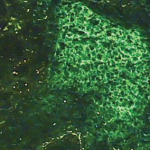Classification criteria for primary Sjögren’s syndrome (SS) have been approved by the American College of Rheumatology (ACR) and European League Against Rheumatism (EULAR), validating an international set of classification criteria for SS using standards set by both organizations. Those criteria can now be found in the 2016 ACR/EULAR Classification Criteria for Primary Sjögren’s Syndrome: A Consensus and Data-Driven Methodology Involving Three International Patient Cohorts, which was published in the Oct. 27 online edition of Arthritis & Rheumatology, as well as Annals of the Rheumatic Diseases.
The new classification criteria are based on the weighted sum of five items, which reflect the higher importance of the immunologic abnormalities granted by the majority of clinician experts:
- Anti-SSA(Ro) antibody positivity and focal lymphocytic sialadenitis with a focus score of ≥1 foci/mm2, each scoring 3;
- An abnormal ocular staining score of ≥5 (or a van Bijsterveld score ≥4);
- A Schirmer test of ≤5 mm/5 minutes; and
- An unstimulated salivary flow rate of ≤0.1 mL/minute, each scoring 1.
Individuals who meet eligibility criteria and who have a total score of ≥4 for the items above meet the criteria for SS.
Multiple Benefits
Caroline Shiboski, DDS, MPH, PhD, at the University of California, San Francisco, and lead author on the paper, says these classification criteria “provide more flexibility than the 2012 ACR criteria and more rigor than the 2002 American-European Consensus Group (AECG) criteria, which included symptoms as criteria items; the new criteria consider symptoms as determinants of eligibility. Further, the new criteria consider systemic signs and B-cell activation biomarkers through the EULAR Sjögren’s Syndrome Disease Activity Index (ESSDAI) as inclusion criteria, which will allow diagnosis of systemic and earlier forms of the disease when sicca features are not already present.”
The new criteria use improved methods that have been outlined by ACR and EULAR and have been applied successfully in the development and validation of the recently revised criteria for systemic sclerosis and rheumatoid arthritis, Dr. Shiboski says. In addition, the criteria eliminate the confusion of having two sets of criteria in active use, one with recognized limitations that is not approved by either ACR or EULAR, and the other recently proposed and only provisionally approved by the ACR.
Further, the new criteria do not include outdated, painful or expensive examinations, such as sialography and salivary scintigraphy, which were part of the AECG criteria. Preexisting lymphoma, which was included in the exclusion criteria list in the AECG criteria, has been deleted from that list, because diagnosis of SS is sometimes made after a prior lymphoma occurrence. Finally, the criteria include another important exclusion criterion, which is IgG4-related disease, and limit HCV infection as an exclusion criterion to active HCV infection with positive PCR, she says.
Criteria History & Development
Eleven classification/diagnostic criteria for SS were published between 1965 and 2002, but they were not endorsed by the ACR or EULAR; the AECG criteria have been the most commonly used classification criteria over the past decade. The ACR Classification Criteria for Sjögren’s Syndrome: A Data-Driven, Expert Consensus Approach in the Sjögren’s International Collaborative Clinical Alliance Cohort was considered a significant step forward when published in 2012, with criteria designed for classifying individuals for enrollment in clinical trials. The criteria were developed using the National Institutes of Health-funded Sjögren’s International Collaborative Clinical Alliance (SICCA) registry, and were based on the need for specificity rather than a reliance on symptoms for a diagnosis, such as dry eyes and dry mouth, which can be nonspecific and caused by other conditions. In the 2012 document, the classification criteria of SS required that a patient have at least two of the following objective features:
- Positive serum anti-SSA and/or anti-SSB or (positive rheumatoid factor and antinuclear antibodies ≥1:320);
- Ocular staining score ≥3; and
- Labial salivary gland biopsy exhibiting focal lymphocytic sialadenitis with a focus score of ≥1 foci/4 mm2.
Analyses were subsequently performed in a cohort of patients at the Oklahoma Medical Research Foundation that compared the ACR and AECG criteria. Those analyses found a high level of agreement. Investigators from both the SICCA team and the EULAR Sjögren’s Task Force formed the International Sjögren’s Syndrome Criteria Working Group in 2012, with the primary purpose of developing classification criteria for primary SS that combined features of the ACR and AECG criteria. The 2016 document is the result of that work.
The Time Is Right
The focus on primary SS is consistent with the working group’s goal of producing criteria that will aid in recruitment of patients for clinical trials. The landscape of SS has changed in recent years due to both the recently validated disease activity indices and the availability of new therapeutic agents, Dr. Shiboski says. “The publication of a single set of classification criteria for SS that has the buy-in of the international SS scientific community and has been approved by ACR and EULAR is extremely timely. The pharmaceutical industry has a number of new therapeutic agents waiting to be tested in clinical trials. Further, a universal set of criteria will greatly improve comparison of results across clinical studies. The new criteria set is also in keeping with ACR and EULAR objectives of elaborating and actively promoting, disseminating and implementing ACR and EULAR recommendations and criteria for the most common rheumatic and musculoskeletal diseases.”
Kathy Holliman, MEd, has been a medical writer and editor since 1997.


